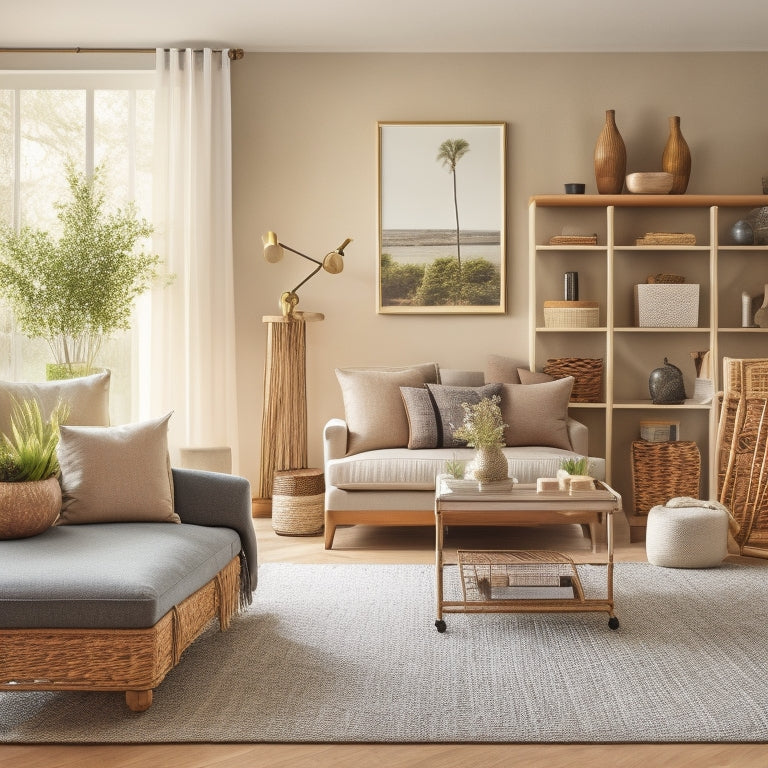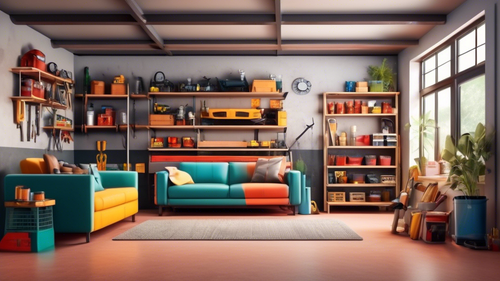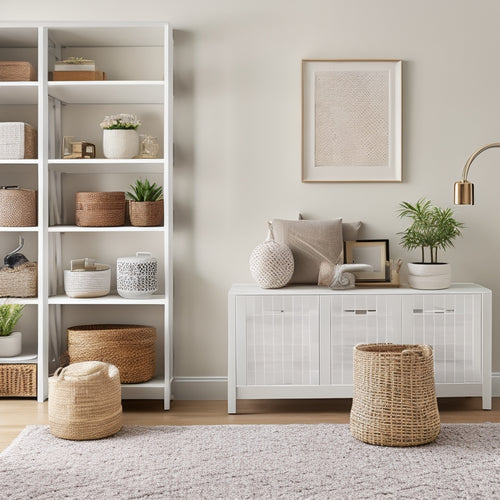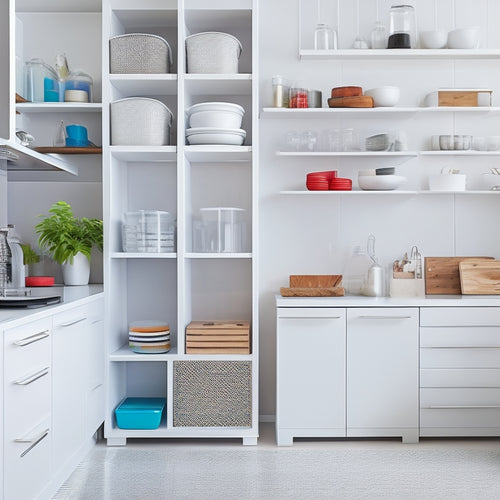
10 Steps to Organize Your Small Home
Share
To organize your small home, start by evaluating your space and needs, then purge clutter and unwanted items by adopting a minimalist mindset and implementing the "one in, one out" rule. Categorize and group similar items, assigning a home for each one, and employ storage solutions like bins and shelves to keep items off the floor. Optimize your furniture layout, manage new items, and create a maintenance routine to stay on track. Add labels and signs for clarity, and replace old items with new, innovative solutions. By following these steps, you'll be well on your way to converting your small home into a haven of organization and productivity - and that's just the beginning of your expedition to a more streamlined, stress-free living space.
Key Takeaways
- Conduct a thorough space analysis to identify areas for improvement and consider personal preferences, lifestyle, and functionality needs for each room.
- Adopt a minimalist mindset, sort items into categories, and ruthlessly purge non-essential items to maintain a balanced possession of goods.
- Assign a designated spot for each item, create zones in the home, and develop habits for returning items to their designated spots to avoid clutter buildup.
- Utilize storage solutions such as wall-mounted racks, hanging baskets, and multifunctional furniture to maximize storage space without sacrificing style or functionality.
- Establish a cleaning schedule, develop a maintenance checklist, and conduct regular inspections to address repair needs early and maintain organization.
Assess Your Space and Needs
As you commence on the expedition of organizing your small home, take a step back to assess your space and needs. Conduct a thorough space analysis to identify areas that require improvement.
Consider your personal preferences, lifestyle, and functionality needs to determine how you want to employ each room. Think about aesthetic considerations, such as the style and color scheme you prefer.
Plan for the future by anticipating changes in your lifestyle and how they may impact your space. Start with one area or task, researching online for organization hacks streamlining living spaces to help you get started.
Evaluate your living spaces regularly to identify areas for improvement. Multi-purpose furniture can be a great investment, but also consider seasonal adjustments you'll need to make.
Involve your family members in the decision-making process to guarantee everyone's needs are met. Be honest about your emotional attachment to certain items and areas, as this will help you make more intentional decisions throughout the organizing process.
Purge Clutter and Unwanted Items
Now that you've assessed your space and needs, it's time to tackle the often-daunting task of purging clutter and unwanted items.
Adopt a minimalist mindset to help you let go of items that no longer serve a purpose. Start by gathering boxes or bags for donations, recycling, and trash.
Decluttering strategies like the "one in, one out" rule can help you maintain a balanced amount of possessions. Be ruthless – if you haven't used it in the past year, it's likely you won't miss it.
Focus on one area at a time to avoid feeling overwhelmed. Sort items into categories, and make decisions about what to keep, donate, or discard.
Categorize and Group Similar Items
Now that you've purged your unwanted items, it's time to categorize and group similar items together.
You'll sort items into categories, like kitchen utensils or cleaning supplies, and then purge any duplicates or unnecessary items within each group.
Sort and Purge Clutter
You're surrounded by clutter, and it's time to tackle it head-on. To adopt a minimalist mindset, you need to sort and purge clutter. Start by categorizing items into "Keep" and "Let Go" piles. Be honest with yourself – when was the last time you used that item? Does it bring you joy or serve a purpose?
| Category | Keep | Let Go |
|---|---|---|
| Clothing | Fitting, worn in the last year | Out of style, ill-fitting, or worn out |
| Kitchen Items | Frequently used, in good condition | Broken, duplicate, or unused |
| Papers | Important documents, receipts to file | Junk mail, outdated papers, or duplicates |
| Decorations | Meaningful, brings joy | Dusty, outdated, or no longer liked |
| Miscellaneous | Functional, serves a purpose | Broken, useless, or no longer needed |
Assign a Home Base
With your clutter sorted and purged, it's time to turn your attention to assigning a home base for the items you've decided to keep. This means categorizing and grouping similar items together, such as all cleaning supplies in one area or all kitchen utensils in another.
Assigning a home base helps you maintain organization and makes it easier to find what you need when you need it. Think about the items you use daily and where they'd be most convenient to store.
Use storage solutions like bins, baskets, or shelves to keep items off the floor and out of the way. By assigning a home base, you'll create a sense of control and structure in your small home.
Store Items Out
From kitchen utensils to cleaning supplies, categorize and group similar items together, making it easy to locate what you need at a glance.
This decluttering strategy helps you maintain a minimalist mindset, ensuring your compact living space remains organized.
Consider outdoor storage solutions, like bins or sheds, for seasonal items like winter gear or summer toys.
Invest in multi-purpose furniture with built-in storage, like an ottoman or coffee table with shelves.
Get creative with containers, using baskets or bins to store items like linens or toys.
Efficient shelving and functional decor, such as storage cubes or hanging organizers, will help keep your belongings tidy and out of sight.
Assign a Home for Each Item
You'll need to designate a spot for each item, so everything has a place to go back to when you're done using it.
Identify item categories, such as cleaning supplies or kitchen utensils, to help you decide where each item should live.
Designate a Spot
Assigning a home for each item is essential to maintaining a clutter-free and organized small home. You'll avoid clutter buildup and make cleaning easier by designating areas for specific items.
Create zones in your home by grouping similar items together, like a reading zone or a cooking zone. Designate a spot for each item within these zones, such as a hook for your keys or a bin for your mail.
This will help you develop habits and make it easier to find what you need when you need it. By doing so, you'll maintain a sense of control and order in your small home.
Identify Item Categories
How do you categorize the items in your small home?
To assign a home for each item, you need to identify the categories they belong to. This step is essential in your decluttering strategies and will help you choose the right storage solutions and organization tools.
-
Seasonal items: decorations, winter clothing, and summer toys
-
Sentimental belongings: family photos, heirlooms, and keepsakes
-
Functional decor: lamps, vases, and wall art
Categorize Item Types
Within the confines of your small home, every item must have a designated spot to guarantee a sense of order and calm.
Categorize item types by grouping similar items together, like books, kitchen utensils, or cleaning supplies. This helps you visualize the storage solutions needed for each category.
Assign a home for each item by designating a specific shelf, bin, or drawer. For instance, all books go on the bookshelf, while kitchen utensils are stored in a designated drawer.
This item organization system assures that everything has its place, making it easier to find what you need and maintain your space.
Utilize Vertical Storage Solutions
Every inch counts in a small home, and that's especially true when it comes to storage. You need to maximize your space without sacrificing style or functionality.
-
Wall-mounted racks and hanging baskets are perfect for storing items like bikes, bags, and cleaning supplies, keeping them off the floor and out of the way.
-
Over the door storage units are great for hanging belts, hats, or bags, and can even be used to store cleaning supplies or linens.
-
Vertical planters and pegboard displays can add a decorative touch while storing plants, tools, or accessories.
Optimize Your Furniture Layout
You've successfully maximized your storage space, but now it's time to think about the flow of your small home. To optimize your furniture layout, consider the scale of each piece and how it affects room flow.
Multifunctional pieces can help streamline the space, while layout symmetry can create a sense of balance. Don't forget about ergonomic design, ensuring each item is functional and comfortable.
Aesthetic balance is key, so strike a balance between form and function. Space zoning can help define different areas within the room, and visual boundaries can separate spaces without closing them off.
Implement a "One In, One Out" Policy
When you implement a "one in, one out" policy, new items will arrive slowly, giving you time to adjust to the change.
Start by purging cluttered spaces first, so you can clearly see what you need to replace.
As you bring in new items, replace old ones to maintain a balanced amount of possessions.
New Items Arrive Slowly
In the midst of your decluttering efforts, it's essential to establish a system to maintain your newly organized space. This means adopting a mindful approach to acquiring new items.
You'll want to slow down the arrival of new possessions to prevent clutter from building up again.
To achieve this, follow these guidelines:
-
Practice mindful purchasing: Think twice before buying something, and ask yourself if you really need it.
-
Set a waiting period: Wait 24 hours before buying something non-essential to make certain you're not acting on impulse.
-
Consider the cost: Factor in the cost of maintenance, storage, and potential disposal when deciding to purchase something new.
Purge Cluttered Spaces First
To tackle clutter effectively, start by purging the most cluttered spaces in your home, as these areas tend to be the most overwhelming and challenging to maintain.
Begin by clearing everything out of the space, and then sort items into three piles: keep, donate/sell, and discard. Be ruthless – if you haven't used something in the past year, it's likely you won't miss it.
Implement a "one in, one out" policy to maintain clutter reduction and reap the benefits of minimalism, such as reduced stress and increased productivity.
Replace Old With New
Now that you've purged your cluttered spaces, it's time to adopt a mindset that will help you maintain your newfound sense of control and accomplishment.
Implement a "one in, one out" policy to guarantee your space stays organized.
Here are three ways to replace old with new:
-
Upgrade essentials: Replace outdated or broken items with modern, functional alternatives that serve your needs.
-
Modernize aesthetics: Update your decor with fresh, stylish pieces that reflect your personal taste and style.
-
Streamline storage: Invest in innovative storage solutions that maximize space and keep clutter at bay.
Create a Maintenance Routine
Your daily grind can quickly turn into a chaotic mess without a maintenance routine. To avoid this, create a cleaning schedule that outlines daily, weekly, and monthly tasks.
Develop a maintenance checklist to help you stay on track. Regular inspections will help you identify and tackle repair tasks before they become major issues.
Don't forget to include seasonal upkeep, like switching out winter and summer clothes, in your routine. Keep essential cleaning supplies on hand to make tasks more efficient.
Effective time management is key to sticking to your routine. Implement efficiency tips, such as grouping similar tasks together, to maximize your productivity.
Make the Most of Hidden Spaces
Make the Most of Hidden Spaces
How can you squeeze more storage out of your tiny abode? Look beyond the obvious spaces and get creative with hidden storage solutions.
-
Utilize underutilized nooks: Think beyond traditional shelves and cabinets. Use innovative shelving to maximize storage in cozy corners.
-
Invest in multifunctional furniture: Opt for pieces with secret compartments or deceptive decor that serve multiple purposes.
-
Employ clever concealment: Add space-saving hacks like hidden drawers or sliding panels to keep clutter out of sight.
Add Labels and Signs for Clarity
As you've successfully maximized your hidden spaces, it's time to bring order to the forefront of your organized oasis. Adding labels and signs is an essential step in maintaining clarity and control.
Start by identifying areas that need categorization, such as storage bins or shelves. Use labeling techniques like color-coding or alphabetical ordering to create a logical system.
Place signs in strategic locations, like above shelves or on cabinet doors, to guide you and others to specific items. Effective sign placement guarantees that everything has a designated home, preventing clutter from building up again.
Frequently Asked Questions
How Do I Stay Motivated During the Organizing Process?
Like Sisyphus, you're determined to conquer the mountain of clutter, but staying motivated can be a challenge. Set specific, achievable goals and create a reward system to celebrate small wins, keeping you driven and focused on the organizing process.
What if I Have Limited Budget for Storage Solutions?
You don't need to break the bank to get organized; instead, you'll find budget-friendly solutions that work for you. Get creative with storage by repurposing items you already own, like turning old crates into shelves or using baskets to corral clutter.
Can I Organize My Home if I Have Pets or Kids?
Oh, you think a chaotic household with pets and kids is an excuse? Think again! You can still achieve pet-friendly organization and kid-proof storage with clever solutions like cubbies, baskets, and labeled bins that'll keep the chaos at bay.
How Often Should I Reassess My Organized Space?
You should reassess your organized space every 3-6 months to maintain organization, ensuring it still meets your needs and adjusting as necessary, so you can stay in control and make intentional changes to optimize your space.
What if I'm Not Good at DIY Projects or Handy?
Don't worry if you're not handy; you can still achieve your organizational goals! Consider hiring professional help, like decluttering services, to tackle tasks that overwhelm you, and focus on maintaining the systems they put in place.
Related Posts
-

Taming the Garage: A Step-by-Step Guide to Organization
Are you tired of tripping over bikes, searching endlessly for tools, and feeling overwhelmed by the chaos in your...
-

Taming the Chaos: 10 Home Storage Hacks
You're tired of living in a cluttered space, where chaos reigns supreme. To tame the mess, start by decluttering with...
-

Maximizing Kitchen Cabinet Storage With Smart Containers
You're ready to maximize your kitchen cabinet storage with smart containers! Start by choosing durable, versatile con...


